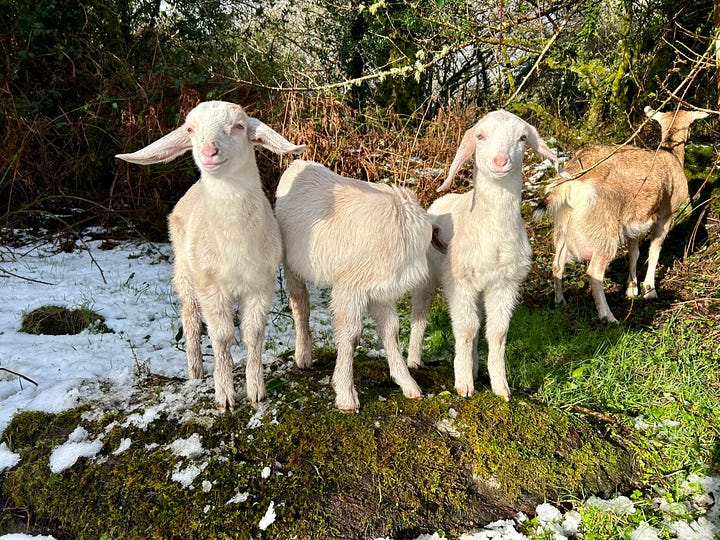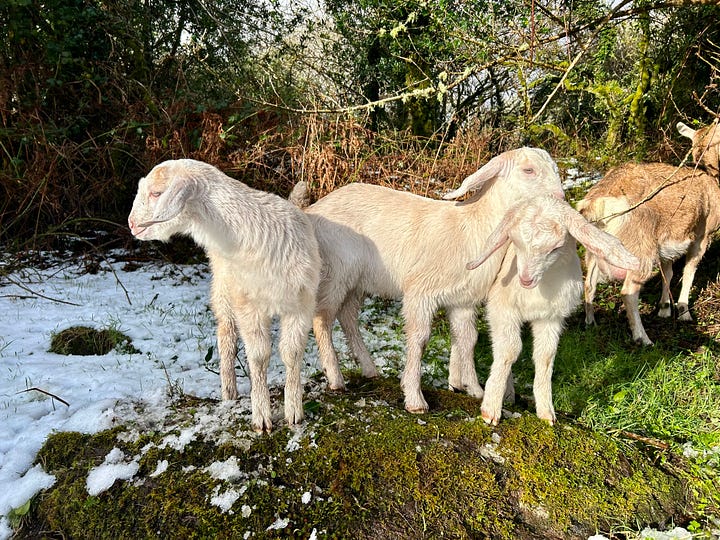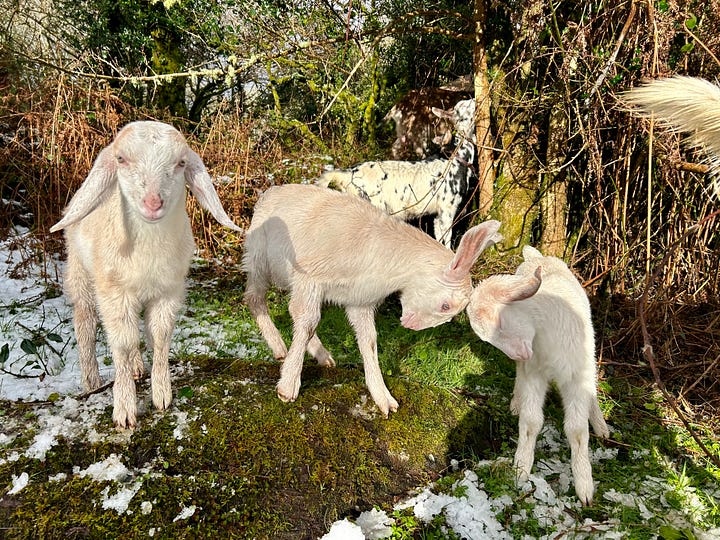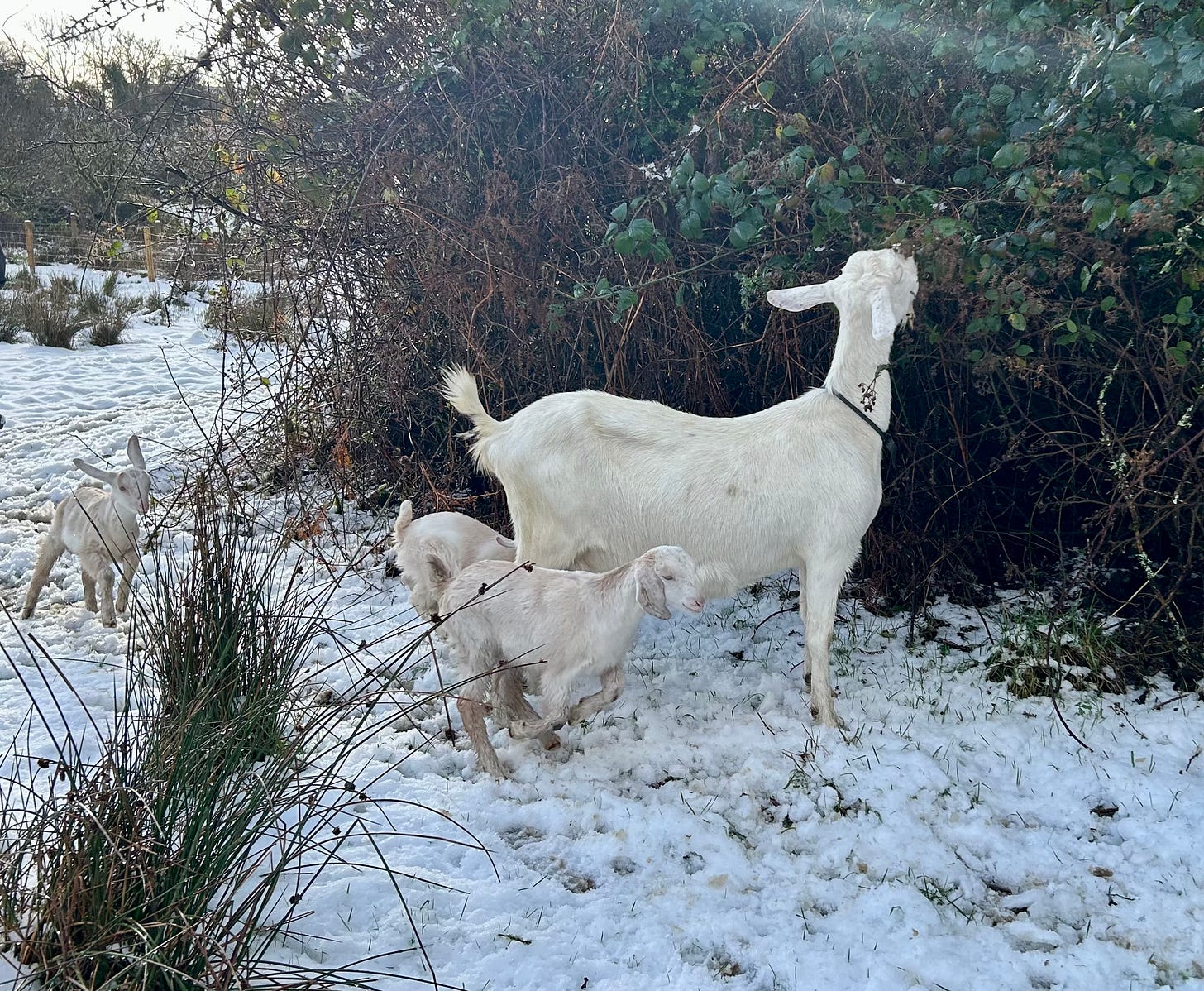Happy New Year friends and readers.
The oily dark of pre-dawn is laced with silver threads that sparkle in my torchlight. Crisp white shimmers and crunches underfoot. Icy whispers fly against my face like the finest snow as I trudge through frozen mist to start my morning rounds before the cold grey break of day. Hungry babies, cosy in the goat house—a literal temple that’s palpably a few degrees warmer than the frigid shed we’re living in with double-glazed windows, insulated ceiling, and a dozen ruminating furnaces belching heat into the air from a thick bed of straw and warm manure, watched over by a consort of Hindu gods from the tiles in the plaster (this old homestead was once home to an oddly placed ashram; we respectfully removed their shrines and converted their temple, which had been originally built a century ago as a poultry house before its conversion to a Hindu temple, into a house for our goats for this winter, for surely no god would deny them the shelter)—greet me with wet kisses, tongues and noses nudging at my fingers for the extra milk I bring to warm their little bods against the early morning chill.
I have never been much of one for new year resolutions. The timing and festivity of the Gregorian new year feels a bit out of step with the stillness and darkness of the season. Truth be told I just haven’t got the energy to start a new fitness regime or quit my morning coffee or embark on any ambitious new project in the throes of deep winter. We tell ourselves every year to remember how bad January actually is and be more prepared, and every year it hits us with a new vengeance. I began writing this at the start of the freeze, before the snow fell thick and full and settled in deep drifts, semi-thawed under a low, wintry sun and then set into treacherous sheets of solid ice, trapping us into this north-facing dip in the hills. We’ve been iced in for days now (I’m not sure how many, these wintry days and nights have rolled into one long, frozen stretch of washing and warming bottles and trudging up and down to the goat house through the fog). We’re melting snow on the wood stove for washing and cooking and collecting drinking water that we hope is clean (it hasn’t killed us yet) from a tiny spring on the land. Our food supplies are running precariously low: we’re down to the hardened rinds of Christmas cheese, half a bag of spuds, a turnip, a few sour cartons of cream, and a shed full of ducks that haven’t pulled their weight in egg production for some time now. Our freezers full of mutton, the mainstay of our simple winter fare of homegrown meat and local veg, are still plugged into a rented power outlet five miles of impassable snow and ice away. We are stranded and unreachable by any but the most intrepid yeti until the thaw.
And yet, at some point in the midst of the freeze, a courier’s van skidded at breakneck speed out of the snowstorm and into our yard, threw out a parcel, and when questioned about the state of the roads the driver, a dark-skinned man with a strong Caribbean accent, replied “is a bit icy yeah” thanked us for our warnings to be careful, then revved back across the the skating rink that is our yard with all four wheels spinning on the ice and slid on his merry way down the icy ravine road, leaving us gaping into his glittering snow trails like we’d just seen a magic reindeer. Meanwhile, regular post and rural transport have been suspended, and the locals chug gingerly about on essential farming errands in tractors and 4x4s. We own neither a tractor nor a 4x4, nor the reckless bravery or iceskating skills of a Fastway delivery driver, so my intrepid husband has set off on a two mile hike over the ice on foot with a sack of haylage over his back for the bucks and rams on the hill and instructions to somehow come back with milk for the kids (goat kids, that is). We may be hungry and held hostage by winter’s wrath, but animals must still be fed.
According to the Celtic Wheel of the Year, the new year begins at Samhain, with the transition from summer to winter around November 1st. That is when the shepherding calendar begins with a new breeding cycle, when we have reaped the year’s harvest and now assess the year’s successes and failures, what worked and what didn’t, and make our plans and adjustments for the coming year. It’s when the stags, bucks and rams rut and the does and ewes are frisky, urgently filling their bellies with the last of the summer’s bounty and the babies they will gestate through the dark months. It’s when the mother oak drops her acorns to the soil, the land falls bare and the seeds for spring are sown. And the first day of spring, Imbolc, literally meaning “in the womb”, is marked as those seeds begin to stir in early February, as life begins to swell and quicken in the soil and in the bellies of the ewes. Now, at mid-winter, those seeds lie dormant in the frozen dark. Now is not the time to burst forth with new life, no, spring will come soon enough with all its emergence and birth and activity and promises of summer’s long, productive days of sweat and toil. Now, deep winter, is time to hunker down in the dark and rest awhile.
But I do like to start the year with a few general themes or intentions, maybe seed some ideas, mull them over, stratify them, gestate them. Some might germinate. Some might grow and thrive in the light of spring and come to bloom. Some might just wither and die, or stay hidden in the dark until conditions are just right. Some might need the cold stratification of a good, hard, winter freeze lest they burst forth from their dormancy too soon.
One of those seeds I’ve been mulling over for a while now is the inklings of my first book. I’ve seen a few writers on here announce their book writing projects recently so I’m not going to make too big a deal out of it nor make any grand promises, but I have begun to pull some scribbles and stories from our two years spent living in a shepherd’s hut on the land into the rough beginnings of a first draft. I’m a slow writer. And some things grow best in the dark. So that’s all I’ll say about that, for now. I will still be writing to you on here weekly, while I tap away quietly on that in the background.
Around the farm, we’re calling this a trial year. It is our first year on new ground, being spread between hill and homestead, so a year to test things out, start a few seeds both literally and figuratively, see what grows, what works and what doesn’t, what emerges when the earth thaws. Nothing too ambitious—we have, after all, still got a burnt-down house to rebuild and a rapidly growing herd of goats demanding every waking minute of my days.




We welcomed the new year in the goat house, bringing midnight milk to the babies, with a vow to never again let the goats kid in winter no matter how hard they wag their tails or flutter their big, buttery eyes outside the buck pen when the weather is fine and the grass is high in July. Molly’s out-of-season triplets born last month completely overwhelmed our Christmas break. Not that I’m complaining, mind. If I must stay up until midnight to see in the new year then I can’t think of a better way to do it than snuggled in the goat house with three adorable, bouncing, snuffling doelings from my best nanny, granddaughters of our queen and matriarch, Fawn the Goat—what a gift to celebrate our first Christmas and start the new year in our new home!
Molly mothers her three girls with endless patience, but there isn’t enough green forage in winter to keep her milky enough for three. She can’t make milk on plain old haylage. She wants nettles and willow leaves and fresh grass, all the green, nutritious things that fall back and lie dormant for winter. When the days are dry we bring the herd out for foraging walks along the track and field edges for Molly to fill her belly and her udder on frosted bramble leaves, ferns and holly and all the winter-green morsels she can find and the babies to run races over the snow and learn to run with the herd. And when it’s raining or snowing or the wind is too bitter to bring the kids out we spend our days getting soaked and frozen and scratched and bruised climbing through the thorny thickets of the woods to cut down and carry in armfuls of ivy which the mob devour in seconds.
Molly tries to make sure all three get their share, but three kids fighting over two teats often means nobody gets any milk. So I layer on my thermals and waterproofs and trudge down to the goat house with warm bottles of milk in my pockets at midnight and in the chill before dawn and multiple times throughout the day to keep the babies topped up sufficiently to see them thriving through the cold. Keeping three topped up evenly is a juggling act requiring round-the-clock hands-on observation and intervention to see who gets a suck from mama goat, pull the extra one out of the scrum when it gets messy to let the other two suck, stick a bottle in its mouth and make sure nobody misses a feed. The delicate little princesses won’t take my emergency bag of powdered whey and palm oil also known as lamb’s milk replacer no matter how stealthily I try to sneak it in and I can’t say I blame them (admittedly, I haven’t tried very hard—I am as reluctant to feed it to them as they are to take it), so we’ve given up our own milk supply, called favours from new friends and spent an arm and a leg to keep our future milkers fed on real goat milk from ours and another local herd to supplement their mother’s milk. I am attempting to sneak them onto cow’s milk this week because all the goats this side of the county can’t keep up with their ravenous appetites for milk, in January.
The main reason we keep the billy goats separate from the female herd for most of the year and (try to) control breeding of our not-very-seasonal domestic dairy breeds to follow the natural cycles of our seasonal climate and coincide kidding with the milder weather and green growth of spring, besides the ladies’ plain objections to constant harassment by stinking, horny bucks, keeping things calm in the goat house and keeping babies on their mothers (bucks do chase pregnant females around until they abort and chase kids off when they try to suckle until they bring the mother back into heat—we know this from experience), is that not much born in our wet, bleak winter would survive for very long without shelter, warmth and extra feeding. Winter birthing means babies reared indoors under artificial light, fed on artificial milk, mothers fed on grains and soy and synthetic supplements to counter the lack of fresh forage, and intensive labour to keep them all fed and warm and alive. Winter birthing means animals raised out of sync with their land and climate, soft and dependent. It is cheating the seasonality of our land and climate to have limitless milk and fresh meat on our supermarket shelves year-round. We aim for spring kidding to have robust kids reared outdoors by milky mothers with milk churned from heather, ivy, brambles and gorse, for the newest members of the herd, and the ones that will become our food, too, to grow in coherence with their landscape and the seasons.
And let us all rest and gestate the seeds of spring and ruminate on the yields of summer past from the warmth of our straw beds in winter.







Happy New Year, Carly. Reading this on the other side of the world where it is summer is a strange feeling. You are an inspiration and you are educating me about the true meaning of living off the land. I’m so glad you have your wonderful husband to share the struggles and the joys with you 💖
How did you even write this with all that's going on?!Fair play Carly x stunning writing